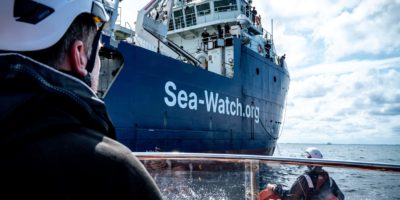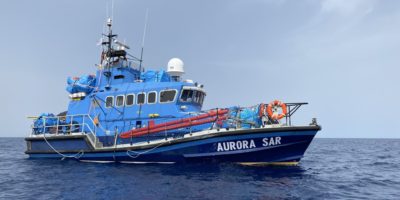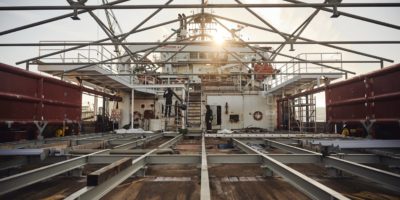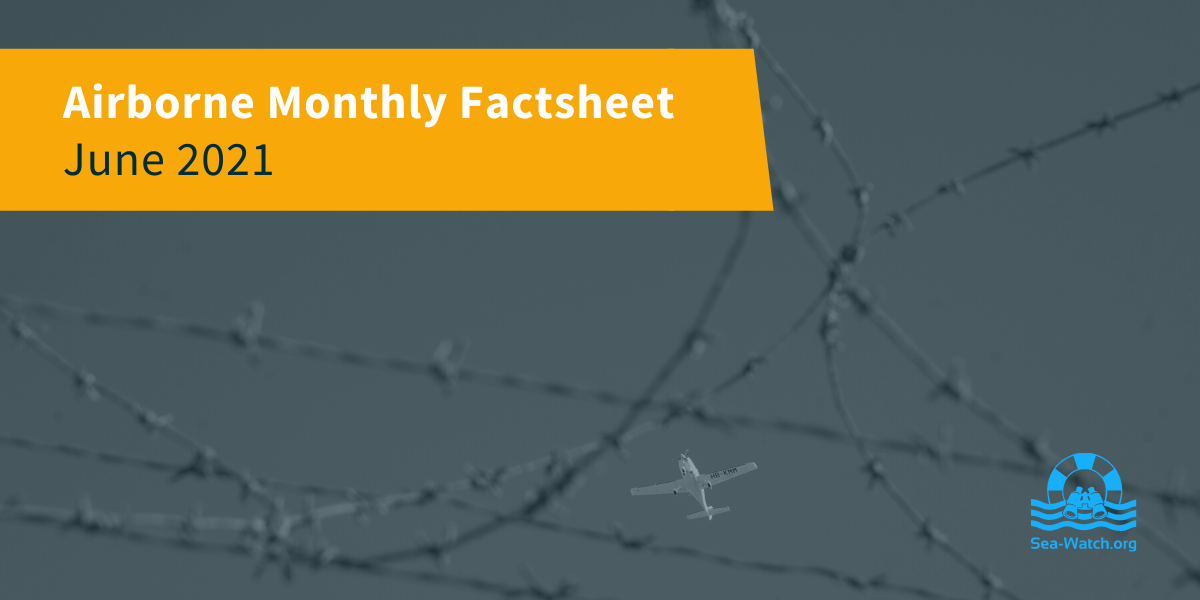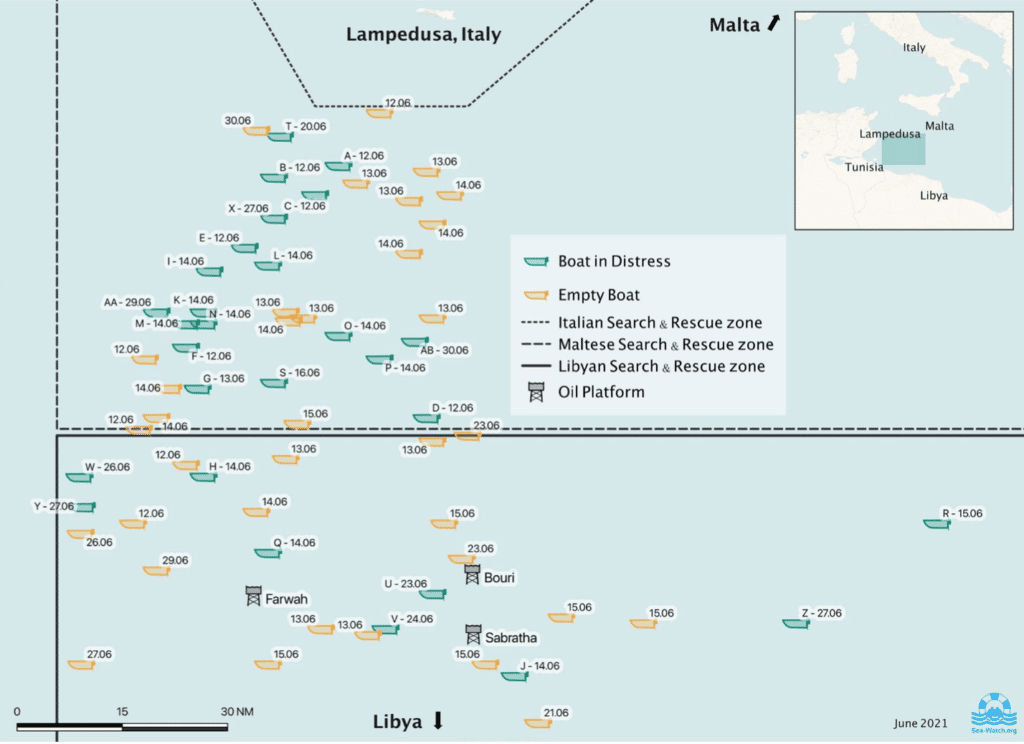This factsheet outlines a summary of the distress cases witnessed in June 2021 by Sea-Watch’s Airborne crew with their aircraft Moon- bird and Seabird.1 In June 2021 we conducted 17 operations, with a total flight time of 101 hours and 50 minutes. We spotted more than 1872 persons in distress aboard 28 different boats.
*Since 2017, together with the Swiss NGO Humanitarian Pilots Initiative, Sea-Watch monitors the Central Mediterranean with its aircraft Moonbird and Seabird.
Overview of Distress Cases and Empty Boats Spotted
Maltese Search-and-Rescue (SAR) zone
- 9 boats in distress, with around 669 persons, are believed to have been rescued by the Italian authorities and disembarked in Lampedusa, Italy
- 2 boats in distress, with around 105 persons, were likely inter- cepted by the so-called Libyan Coast Guard and pulled back to Libya
- 1 boat in distress, with 80 persons, was rescued by the NGO vessel Geo Barents** and disembarked in Augusta, Italy
- 1 boat in distress, with 86 persons, was assisted and rescued by the NGO vessel Nadir*** and transshipped to the Italian Coast Guard before being disembarked in Lampedusa, Italy
- The outcome of 6 boats in distress, around 237 persons, remains unknown
- Estimated**** number of persons in distress: 1177
Libyan Search-and-Rescue (SAR) zone
- 1 boat in distress, with between at least 120 and 270 persons5, was rescued by the merchant vessel Vos Triton, transshipped to a so-called Libyan Coast Guard patrol boat, and then pulled back to Libya
- 5 boats in distress, with around 215 persons, were likely intercepted and pulled back to Libya by the so-called Libyan Coast Guard
- The outcome of 3 boats in distress, with around 360 persons, remains unknown
- Estimated4 number of persons in distress: more than 695
1. Details and outcomes of the distress cases
On 12.06., Seabird’s crew spotted 6 boats in distress carrying 414 persons.
12.06., around 100 persons: completed rescue operation by a merchant vessel in the Maltese Search-and-Rescue (SAR) zone. Seabird’s crew spotted a completed rescue by a Turkish vessel, the Uğur Dadaylı, in the Maltese SAR zone. The boat was empty and all persons were safely on board. The rescued people were disembarked in Malta.
12.06., distress case D, with around 15 persons: so-called Libyan Coast Guard patrol boat with around 80 persons on deck, illegal interception in the Maltese (!) SAR zone of around further 15 persons. Seabird’s crew spotted a so-called Libyan Coast Guard patrol boat, with around 80 persons already on its deck, on-scene a boat in distress with around 15 persons in the Maltese (!) SAR zone. All of the people were intercepted and pulled back to Libya.
On 14.06., Seabird’s crew spotted 10 boats in distress carrying more than 715 persons.
14.06., distress case H, with between at least 120 and 270 persons*****: the merchant vessel Vos Triton transshipped persons to the so-called Libyan Coast Guard in the Libyan SAR zone.******
The initiative Watch the Med – Alarm Phone received a call from a boat with around 120 people on board and immediately alerted the authorities. Seabird’s crew spotted the people adrift in the Libyan SAR zone while the merchant vessel Vos Triton, flying the flag of Gibraltar, was in the direct vicinity. Several people jumped over- board and attempted to swim to the Vos Triton, which then started its engine. The people were eventually rescued by the Vos Triton. Seabird left the scene. Seabird’s ground crew later observed that the merchant vessel had started to head south. Seabird’s aircrew overheard a communication on the radio between the so-called Libyan Coast Guard and the oil platform Farwah mentioning that the Vos Triton would hand over the people to the so-called Libyan Coast Guard. During the late afternoon, Seabird’s crew witnessed the so-called Libyan Coast Guard boarding the merchant vessel in order to transship the people and pull them back to Libya. Due to a lack of fuel, Seabird’s crew was obliged to leave the scene. The UNHCR and IOM confirmed later that the Vos Triton had transshipped “over 270” people to the so-called Libyan Coast Guard. The people were pulled back to Libya. Throughout the entire operation, Seabird’s crew unsuccessfully reminded the Vos Triton over the radio of its obligations to ensure that the persons would be disembarked in a place of safety.
15.06., an empty boat, results of a likely interception in the Libyan SAR zone. Seabird’s crew spotted an empty deflated yellow boat in the Libyan SAR zone. The so-called Libyan Coast Guard was in the direct vicinity with around 160 persons on deck. We assume that they were intercepted shortly before Seabird’s crew arrived on-scene. The people were likely pulled back to Libya.
16.06., distress case S, with 86 people: NGO vessel left alone by the authorities, attempted pushback in the Maltese SAR zone likely coordinated by the Maltese authorities. The people in distress had called the initiative Watch the Med – Alarm Phone, which informed the authorities. Seabird’s crew spotted the people in the Maltese SAR zone, not wearing any life vests. The Maltese authorities were called by the ground crew and replied that they were busy though would have a look at the respective emails and get back to Sea-Watch – which they never did. When called again, the Maltese authorities stated on the phone that Seabird was “an NGO aircraft, not a RCC, [they are] not in the position to give [us] such information”. The monitoring sailing vessel Nadir, operated by the NGO RESQSHIP was on-scene, stabilised the situation and took some of the people on board. The Nadir was informed that RCC Malta was coordinating the case. According to RESQSHIP, the so-called Libyan Coast Guard arrived on-scene, requesting that the Nadir hand over the people, which was refused by the NGO. The so-called Libyan Coast Guard then left the scene, came back and left again. The Italian Coast Guard ultimately transshipped the people from the Nadir and disembarked them in Lampedusa, Italy.
20.06., distress case T, with 56 persons: shifting of responsibility between Italian and Maltese authorities, lack of cooperation with NGOs. Seabird’s crew overheard radio communications in Lampedusa mentioning around 40 persons in distress. Seabird’s crew spotted the people in the Maltese SAR zone, as one Carabinieri******* boat and one Guardia di Financia boat were approaching. The Italian authorities officially informed the Maltese authorities, putting Sea-Watch in copy and urged them to “please take any appropriate action from your side, keeping this MRCC kindly informed”. So far as we are aware, Malta did not react to this email. The people were rescued and disembarked in Lampedusa, Italy during the evening. When the Italian authorities were called the next day by the ground crew in order to confirm the disembarkation, the duty officer said that they “don’t have any information to share”.
23.06., 24.06., distress case U, V, respectively with each around 20 persons: non-assistance by several Italian merchant vessels resulting in interceptions and pullbacks to Libya.
On 23.06., distress case U, Moonbird’s crew spotted around 20 persons in the Libyan SAR zone. The merchant vessels Asso Ventinove and Asso Venticinque, both flying the Italian flag, were respectively 2 and 7 nautical miles (nm)8 away from the people. Neither of the vessels responded to any of the attempts at communication from Moonbird’s crew on the radio. The merchant vessel Almisan, flying the Italian flag, was near the oil platform Sabratha********* and also remained unresponsive. Later, the oil platform Bouri********* informed Moonbird’s crew on the radio that they were waiting for the so-called Libyan Coast Guard to “release” one vessel to undertake the rescue, likely as the “competent” authority. The Italian authorities were informed but refused to provide any information as to which vessel would assist the persons in distress. The Italian shipping company operating the merchant vessels, Augusta Offshore S.p.A, was unaware of the situation and recommended that an email should be sent to them regarding the situation – which was done immediately by ground crew. When the ground crew called 2 different numbers of the Libyan authorities: either nobody answered or they could not speak English. When the Italian authorities were called again in the evening, they refused to share any information as “the boat is not in Italian area“. On the next day, 24.06., the Italian authorities still did not provide any information and said “[they] are doing [their] job”. The position of the people coincided with the position of the orbit of a Frontex operated drone on 23.06 in the morning – before Moonbird’s crew, which leads us to conclude that Frontex at least knew about the distress case and possibly passed the information on to the so-called Libyan Coast Guard. According to information provided by the JRCC Tripoli, the people were intercepted and pulled back to Libya.
On 24.06., distress case V, Moonbird’s crew again spotted around 20 persons in the Libyan SAR zone. In terms of the closest vessels able to render assistance, Moonbird’s crew tried again to reach out to the merchant vessel Almisan, which was 8 nm away from the people but remained unresponsive. The merchant vessel Asso Trenta, flying the Italian flag, stated that it was engaged in an operation, while the Asso Ventinove stated that it was waiting for permission from the so-called Libyan Coast Guard, likely as the “competent” authority, to engage in a rescue operation. Both of these vessels were 13 nm away from the people. As the people in distress were adrift, they were at a high risk – Moonbird’s crew therefore sent out a “mayday relay”.********** The oil platform Bouri then informed the so-called Libyan Coast Guard. Ground crew reached out to the Italian shipping company again, Augusta Offshore S.p.A, as well as the insurance company, but both remained unresponsive. The Italian authorities were informed via email and via phone. On the phone, the officer stated that he would “pass on to the competent authorities”. According to the Libyan authorities, the people were intercepted and pulled back to Libya.
26.06., distress case W, with around 80 people: non-assistance by a merchant vessel, unknown outcome. Seabird’s crew spotted around 80 persons in the Libyan SAR zone. The merchant vessel Maridive 601 was in the vicinity but remained unresponsive to the aircrew’s calls over the radio. Maridive’s shipping company was also informed via email, though the company remained unresponsive. The outcome of the distress case remains uncertain.
On 27.06., Seabird and Moonbird ‘s aircrew spotted 3 boats in dis- tress, carrying 250 persons.
27.06., completed interception and pullback by the Libyan Coast Guard in the Libyan SAR zone, Tunisian Coast Guard patrol boat in the vicinity. Moonbird’s crew spotted the completed interception of around 100 persons in the Libyan SAR zone by the so-called Libyan Coast Guard. The boat was empty and all people were on the deck of the so-called Libyan Coast Guard vessel.
A Tunisian Coast Guard patrol boat and another so-called Libyan Coast Guard patrol boat were in the vicinity. The people were pulled back to Libya.
27.06., distress case Z, with around 80 people: unprofessional and dangerous interception and pullback coordinated by an aircraft from the Armed Forces of Malta. Seabird’s crew overheard via radio a source providing the so-called Libyan Coast Guard with a position in the Libyan SAR zone. We believe this source to be a Maltese aircraft. When Seabird arrived on-scene, around 80 persons were in distress and the Maltese aircraft Mission27 was also circling. The so-called Libyan Coast Guard patrol boat Ubari arrived at the position of the people in distress, however it seems that the people resisted and refused to be intercepted. One so- called Libyan Coast Guard officer jumped overboard to swim and attach a rope to the rubber boat in order to bring it alongside the patrol boat. Ultimately all of the people were intercepted and pulled back to Libya.
29.-30.06., involvement of a fishing vessel, persons in distress in the vicinity of Lampedusa. Seabird’s crew overheard a communication between Lampedusa radio and a fishing vessel, which included a position. 45 people were believed to be in distress. On the next day, Seabird’s crew spotted an empty rubber boat which might have corresponded with the communication overheard the day before, as well as a NAVTEX*********** which was sent out by Malta about an empty rubber boat. The people are assumed to have been rescued by the Italian Coast Guard to Lampedusa.
29.06., distress case AA, with 110 people: non-assistance by merchant vessels and authorities turning a blind eye to people in distress. The people had called the initiative Watch the Med – Alarm Phone, which immediately alerted the authorities. Seabird’s crew spotted the people in distress in the Maltese SAR zone. Two merchant vessels, the Norrland, flying the flag of Cyprus, and the Seabright, flying the Maltese flag, refused to assist the people – arguing on the radio that the “water was too shallow”. The weather conditions were deteriorating over the evening. On the next day, Seabird’s crew spotted an empty boat which looked like the boat in question. The people are assumed to have been rescued to Lampedusa by the Italian authorities.
29.-30.06., communication overheard on the radio, shipwreck near Lampedusa. On 29.06. at the end of Seabird’s operation that day, the crew overheard a communication on the radio regarding a boat carrying around 50 persons in the Maltese SAR zone, near the Italian SAR zone boundary. On 30.06, the ground crew offered support to the Italian authorities, which declined the invitation when they realised that Sea-Watch was an NGO, after informing that 2 aircraft and at least 4 patrol boats had already been deployed. According to media reports, the boat capsized upon its rescue by the Italian authorities, whereupon at least 7 persons died.
30.06., distress case AB, with 63 people: use of violence and dangerous manoeuvres by the so-called Libyan Coast Guard in the Maltese SAR zone. Seabird’s crew overheard a communication
on the radio about a position of people in distress. When Seabird arrived in the area, a so-called Libyan Coast Guard vessel was heading at full speed towards the scene. There was a fishing vessel taking the rubber boat to its side. The Maltese authorities were informed on the phone and said that they were “investigating the case”, but hung up when the ground crew reminded them about the illegality of a potential pushback. Meanwhile, the so-called Libyan Coast Guard patrol boat was on-scene. Attempting to stop the boat, the so-called Libyan Coast Guard fired into the water************, circled the people who were trying to flee, attempted to deploy a rope to catch the boat and also attempted to ram the boat, approaching it too fast and too close. When Seabird’s crew urged them on the radio to stop their illegal and dangerous manoeuvres, the so-called Libyan Coast Guard replied that they “had to rescue as it is bad weather tomorrow”. More than an hour after arriving on-scene, the so-called Libyan Coast Guard started to head south. The people arrived safely and autonomously in Lampedusa, Italy.
In June 2021, Seabird’s and Moonbird’s crews spotted 35 empty boats. Only 3 of these were likely boats spotted the day before by the crews when there were still people on board. 1 boat was likely rescued by the Italian authorities and disembarked in Lampedusa. 1 was the remnant of a rescue operation by the NGO vessel Geo Barents. 8 are believed to have been intercepted and pulled back to Libya. The outcomes for the 25 other empty boats are unknown.
2. Frontex drone complicity in human rights violations
In May 2021, the European Coast Guard Agency Frontex began operations with a drone (AS2132) deployed from Malta. As far as we know, no Frontex aircraft was flying in June. The drone’s footage is transferred to Frontex headquarters in Warsaw in real-time – and hence this operation does not encounter problems such as crew fatigue, also having the capacity to fly for much longer than a crewed aircraft. In June, Airborne witnessed the flagrant illegal cooperation between Frontex and the Libyan authorities on multiple occasions. We must conclude that the drone was involved in at least 10 boats in distress: 8 likely interceptions by the so-called Libyan Coast Guard and consequent pullbacks to Libya. The outcome of 2 boats remains unknown.
13.06., distress G, with around 90 persons: interception in the Maltese (!) SAR zone, likely coordinated by Frontex. The initiative Watch the Med – Alarm Phone was called by the people in the Maltese SAR zone and immediately alerted the authorities. While Seabird was flying, the ground crew observed the Frontex drone orbiting the position given by the Alarm Phone. Seabird’s crew spotted the people around 20 minutes later as well as their interception in the Maltese (!) SAR zone by the so-called Libyan Coast Guard. The people were pulled back to Libya.
13.06., 2 empty and probably intercepted boats, likely coordinated by Frontex. While Seabird was flying, the ground crew observed Frontex’s drone orbiting above three positions, two of these likely matching to the same boat. On 2 occasions when Seabird’s crew arrived on-scene where the drone circled, there was an empty boat in the position. On one occasion, the so-called Libyan Coast Guard were in the vicinity with around 100 persons on their deck. We have to assume Frontex coordinated these interceptions and pullbacks to Libya.
15.06., distress case R, with around 15 persons: likely interception and pullback, coordinated by an unidentified source and probably Frontex. Seabird’s crew overheard a communication from an unidentified source, giving a position on the radio. When Seabird’s crew arrived on-scene, a boat with around 15 persons in distress was visible. Four minutes after the ground crew informed authorities via email, Frontex’s drone orbited at the position of the people in distress. Meanwhile, Seabird’s crew observed a so-called Libyan Coast Guard patrol boat heading at full speed towards the people. We assume that the people were intercepted and pulled back to Libya under the coordination of Frontex.
21.06., empty boat in the Libyan SAR zone, interception likely coordinated by Frontex. Seabird’s ground crew observed the drone orbiting in the Libyan SAR zone. The JRCC Libya later confirmed that they had received a position via email that corresponds with the observed orbit and that they were sending an asset. Later, Seabird spotted an empty boat at the position. The Libyan authorities confirmed afterwards that the people had been intercepted and that the so-called Libyan Coast Guard patrol boat was returning to Tripoli.
These missions highlight once again:
- the deadly consequences of European migration and border policies
- the systematic non-assistance of European Member States and their delegation of rescue operations to the so-called Libyan Coast Guard, even in European SAR zones
- the participation of European aircraft in interceptions and pullbacks undertaken by the so-called Libyan Coast Guard
- the involvement of merchant vessels in rescue operations and interceptions due to the lack of a European rescue program
- the need for NGO vessels in the Central Mediterranean Sea in order to uphold the law and save human lives

